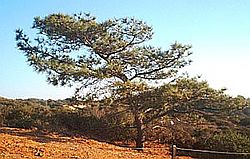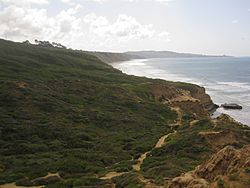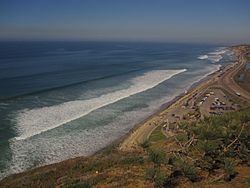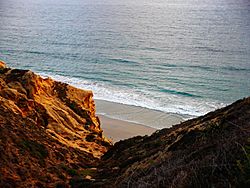Torrey Pines State Natural Reserve facts for kids
Quick facts for kids Torrey Pines State Natural Reserve |
|
|---|---|
|
IUCN Category V (Protected Landscape/Seascape)
|
|
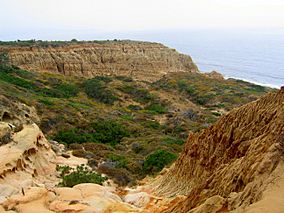
Torrey Pines State Natural Reserve
|
|
| Location | San Diego, California |
| Area | 2,000 acres (8.1 km2) |
| Designated: | 1977 |
Torrey Pines State Natural Reserve is a super cool coastal state park located in San Diego, California. Imagine a wild, beautiful stretch of land right on the Southern California coast! This amazing reserve covers about 2,000 acres. It's next to the famous Torrey Pines Golf Course on one side and the city of Del Mar on the other. In 1977, it was named a National Natural Landmark, which means it's a really special place!
The reserve has a high plateau with cliffs that look out over Torrey Pines State Beach. There's also a lagoon that's super important for seabirds that are migrating. You can find all sorts of plants and animals here. Look out for bobcats, foxes, raccoons, coyotes, and rabbits! There are also cacti, coastal chaparral, and the very rare Torrey pine trees. If you visit during whale migration season, you might even spot humpback whales and gray whales from the cliffs!
With 8 miles of trails, the park is a fantastic spot for hikers and beach lovers. There's even a small museum at the top of the hill. From the cliffs and many spots on the beach, you can see La Jolla to the south and Del Mar to the north. At the very end of the beach, there's a big rock called Flat Rock that sticks out into the ocean.
Contents
How Torrey Pines Became a Special Place
This area has been home to several Native American groups for a very long time, including the Kumeyaay people. Back in 1899, a man named George Marston convinced the San Diego City Council to protect 364 acres of land as a park. Later, between 1908 and 1911, a kind newspaperwoman named Ellen Browning Scripps bought even more land and gave it to the city.
In 1916, Guy Fleming visited the park and saw how important it was to protect. He worked hard to preserve it and later became a superintendent for California's state parks. The Torrey Pines Lodge was finished in 1923, and more land was added. Soon, the park, with over 1,000 acres of cliffs and beach, was open for everyone to enjoy.
In 1956, the park was given to the State of California for even better protection, becoming a state reserve. More land and trees were added in 1970 to protect it from growing cities. In 1975, the Torrey Pines Docent Society was started. This group helps protect the park and runs the Visitors Center. In 2007, the park's name officially changed to Torrey Pines State Natural Reserve. Today, the park is over 2,000 acres!
Amazing Nature at Torrey Pines
The Rare Torrey Pine Tree
The Pinus torreyana torreyana, also known as the Torrey pine, is the rarest pine tree in all of North America! These trees have a special root system that helps them hold onto the bluffs. Torrey Pines is the only place in the entire world where this exact type of pine tree grows naturally. There's a similar type of Torrey pine that grows on Santa Rosa Island.
Other Plants and Animals
Even though the Torrey pine is super rare, the reserve is also home to many other cool plants and animals. The weather here can be a bit unusual because of the Santa Ana winds, which can make the plants drier. You can find plants like Coastal sage scrub, Coastal Strand, and Salt marsh thriving at Torrey Pines. It's a busy place for wildlife too, with many different creatures making their homes here.
Exciting Trails to Explore
Torrey Pines State Natural Reserve has 8 different trails for hikers. They vary in length, how hard they are, and what you can see along the way. Three popular trails are the Guy Fleming Trail, Razor Point Trail, and Beach Trail.
- The Guy Fleming Trail is about 0.7 miles long and is the easiest trail. It offers amazing views, from the Peñasquitos Marsh to the distant city of La Jolla. In winter, it's a great spot for whale watching!
- The Razor Point Trail is a 1.4-mile loop. This trail lets hikers see cool ravines and unique land formations called badlands, all while looking out at the ocean.
- The Beach Trail is about 0.75 miles long and takes you right down to Torrey Pines State Beach. It might not have as many scenic overlooks as the others, but it's very popular because it leads straight to the wide-open beach!
Other trails you can explore include the Parry Grove Trail, Yucca Point Trail, High Point Trail, Broken Hill Trail, and Discovery Trail.
Staying Safe at Torrey Pines
The cliffs at Torrey Pines are made of sand and can sometimes be unstable. It's very important to always stay on marked trails and away from the edge of cliffs. Nature can be unpredictable, and sometimes parts of the cliff can break off. Park rangers and staff work hard to keep visitors safe. If you're ever hiking and need help, emergency services are available. For example, in 2014, a hiker needed help from a cliff rescue team after an ankle injury on a trail. Always be aware of your surroundings and follow all safety signs!
Gallery
-
A Torrey pine showing how the wind shapes its branches
See also





